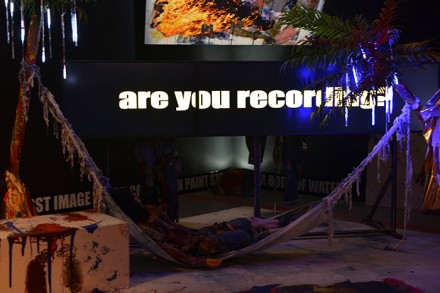
Korakrit Arunanondchai, Painting with history in a room filled with people with funny names 3 (2015), all photos by D. Mookherjee for Art Observed
Painting with History in a room filled with people with Funny Names 3 is a monographic exhibition displayed at the Palais de Tokyo, in Paris, presented by Thai artist Korakrit Arunanondchai, and concluding a series of works started in 2011. The exhibition gathers performances, installations and videos that question the apprenticeship of a painter through the prism of an exchange between the artist and his alter ego Chantri, and his incarnation as a recurring fictional character, the Thai Denim Painter. This exhibition finalizes the artwork initiated with the two previous pieces by dealing with Arunanondchai’s core theme; his identity, a structured representation of his artistic life, the social realities of Thailand and the phenomena of globalization, all mingled together here to form what he refers to as a “Memory palace.”
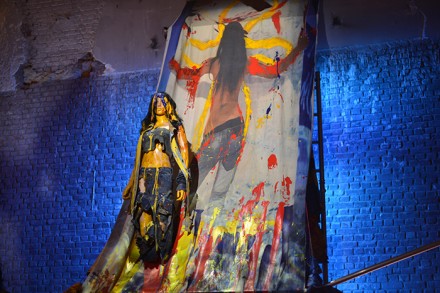
Korakrit Arunanondchai, Painting with history in a room filled with people with funny names 3 (2015)
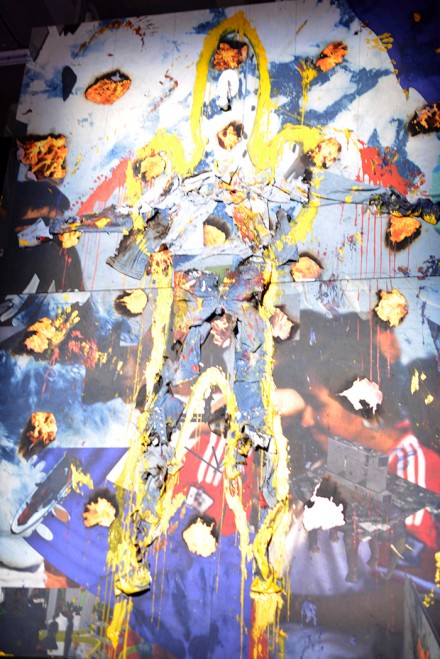
Korakrit Arunanondchai, Painting with history in a room filled with people with funny names 3 (2015)
The concept of duality haunts Arunanondchai’s work, with the balance between conscious and unconscious, reality and fiction, heaven and hell, introduced by the Thai Denim Painter character. The character serves as a parallel to a body painting performed by a Go-go dancer on a Thai TV program. Her nudity, which embodies the darker, repressed sides of Thai reality, serves in part as the unconscious part of the Thai mind – against the virtuous constructs of Buddhism. This duality, personally experienced and expressed by the artist, shapes the exhibition in two rooms, Body and Spirit.
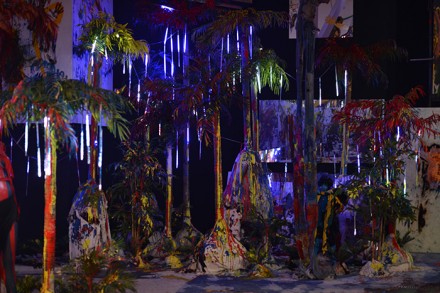
Korakrit Arunanondchai, Painting with history in a room filled with people with funny names 3 (2015)
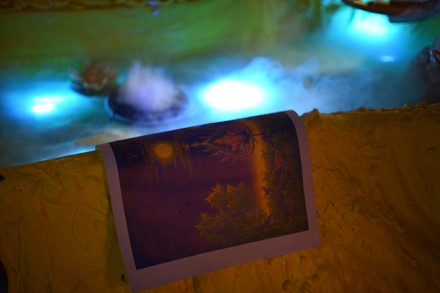
Korakrit Arunanondchai, Painting with history in a room filled with people with funny names 3 (2015)
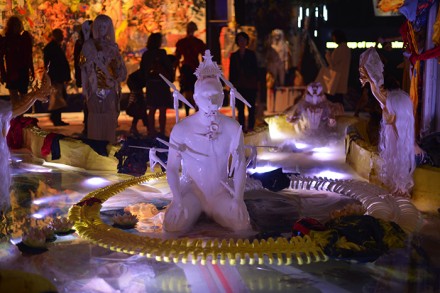
Korakrit Arunanondchai, Painting with history in a room filled with people with funny names 3 (2015)
The Body, an immersive space that offers an instant physical, and overwhelming experience, catches the viewer’s attention through various experimental mediums, from models, to sculptures of snakes with human heads, a rain of colorful garlands and neons, displays, coffins, mangas, and other elements that are present in his video, all starkly presented against the dimly lit room. The white religious sculpture, crowned with drone propellers and sitting in a basin in the middle of the room, is a reminiscence of the temple which Arunanondchai filmed the corresponding video in. Many clothes are spread in the room, community symbols which he glorifies through religion, musicians, or the Bangkok Denim Gang (his crew of identically dressed Thai compatriots), transmit an idea of a uniform belonging that connects both body and people.
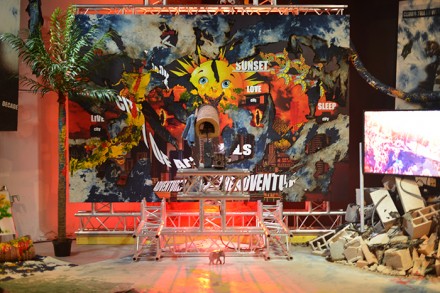
Korakrit Arunanondchai, Painting with history in a room filled with people with funny names 3 (2015)
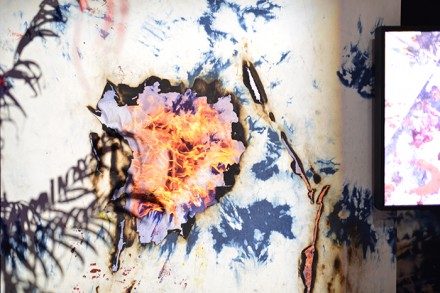
Korakrit Arunanondchai, Painting with history in a room filled with people with funny names 3 (2015)
The wall and the floor are covered with a large denim body painting, a recurring theme for the artist and a symbol for globalization, with many scaffolds throughout the space serving as hanging for his large canvases. The spectator is placed within the work on the outsized denim sheets that become both stage and scenery, and enters the artist’s indeterminate universe, constantly oscillating between reality and fiction. His fluid identities are conveyed by visual personal references, like Thai director Apichatpong Weerasethakul, and a number of archives that adorn every inch of the room. The “Membrane” space, passing between rooms, absorbs the visitor into its elements. Mannequins dressed in denim confound the viewer,while impairing the perception of true and fictitious.
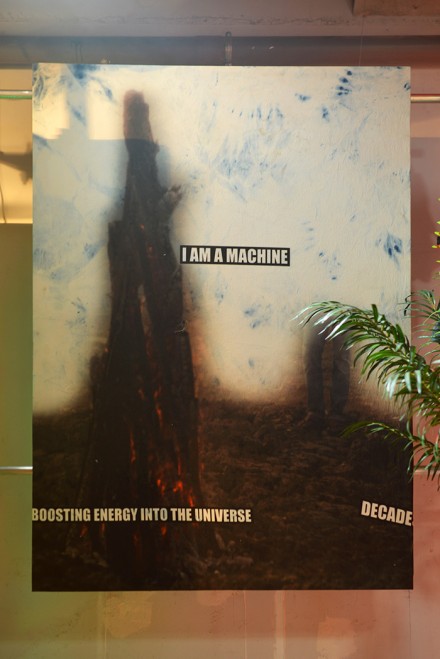
Korakrit Arunanondchai, Painting with history in a room filled with people with funny names 3 (2015)
“I am a Machine boosting the energy of the universe,” a recurrent phrase in the video and the showroom illustrates the thoughts of Arunanondchai vis-a-vis the highly connected world in which we live. He manifests this connectivity through his sculptures, always stressing the intangible elements of the work.
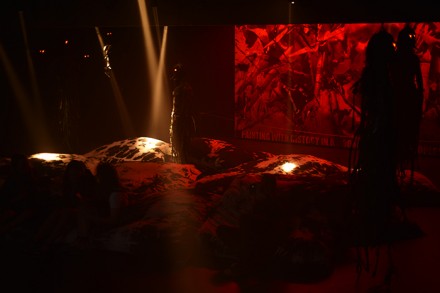
Korakrit Arunanondchai, Painting with history in a room filled with people with funny names 3 (2015)
The almost unlit corridor that leads to “Le Point Perché,” seems a metaphor of the passage from the Body to the Spirit, and gives the visitor the feeling of arriving in the intimate space of the artist’s mind. Filled with a booming soundscape, the viewer is pulled into a contemplation of the display and the suspension of red-eyed sculptures made of electric cable, which strengthens a sense of hyper-connectivity and technological forces.
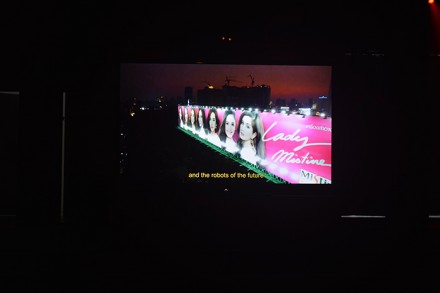
Korakrit Arunanondchai, Painting with history in a room filled with people with funny names 3 (2015)
In the 24 minute video, his dialogue with Chantri, the spiritual alter ego serves as a “device to speak to the audience with the filter of proximity,” delivering key touchstones of the work to the viewer. The two voices alternate, Arunanondchai in Thai and English and Chantri in French, disrupting the balance of identity. Celebration of the Bangkok Denim Gang, the life of the artist, his relationship to his twin brother, news fragments, pieces of his previous work, including his performance at MoMA PS 1’s Art Basel Miami Beach Party, and scenery of Bangkok and Thailand all conspire with Arunanondchai to expose paradoxes of his home country in the throes of modernity. These are juxtaposed with pictures of established artists such Picasso and Basquiat, and The Bangkok Denim Gang, smoking in matching outfits. There is a constant questioning of the artist’s status in a world ruled by technology. Enumeration of sentences like “The projection will become our reality”, “Mountains of broken hard-drives,” “The spirit becomes a camera”, paralleled with 3-D images and technological mediums present Chantri embodied as a drone flying over Korakrit. He says in the video: “The spirit has the knowledge to overcome the system.”The question remains, however, whether Chantri is projected into the air around him, or whether it serves as his bulwark against modernity.
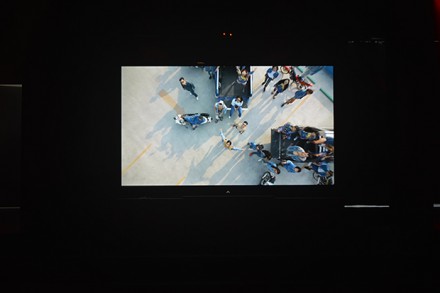
Korakrit Arunanondchai, Painting with history in a room filled with people with funny names 3 (2015)
The notion of time, evolution and chronology in his work preoccupies Arunanondchai, and justifies the act of memory as a questioning of fiction and reality, consciousness and unconsciousness, symbolism and dream. His life becomes his work, and his exhibition a capsule in which the viewer is projected. In the last part of the video, the temple and the act of body painting merge, underscoring the spiritual multiplicities that the artist embraces as a part of his person.
— D. Mookherjee
Read more:
Korakrit Arunanondchai, [Palais de Tokyo]
Korakrit Arunanondchai [Artist’s Website]
Korakrit Arunanondchai gallery [C L E A R I N G]
Korakrit Arunanondchai gallery [CARLOS/ISHIKAWA]



